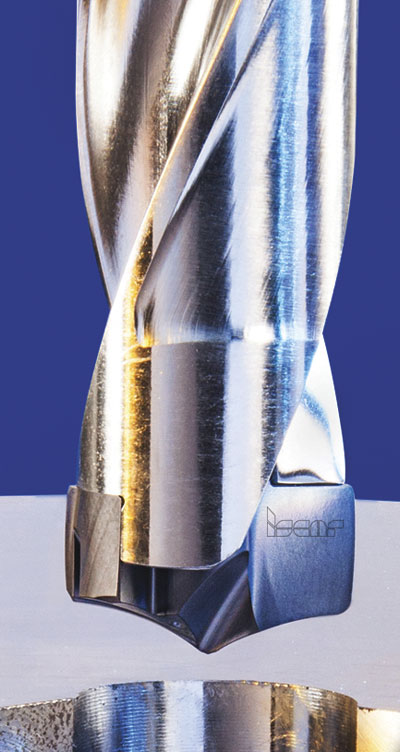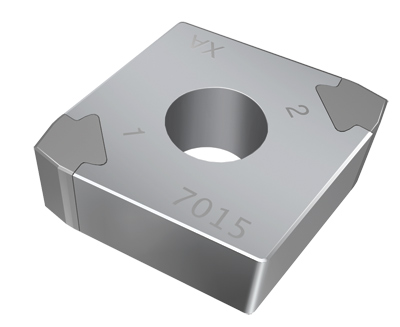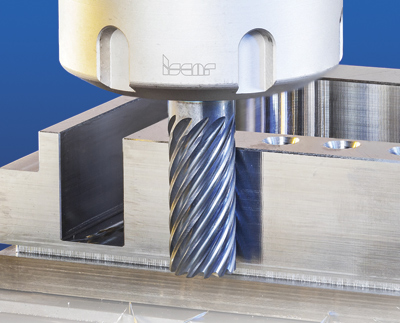by Mary Scianna
Tips to help you succeed in aerospace machining
If done right, aerospace parts manufacturing can be a rewarding and lucrative business for a machine shop, but as many know, mistakes can be costly in more ways than one: not only may you end up scrapping expensive parts, you can lose business because of such mistakes.
What are the best cutting strategies to ensure you machine your parts right the first time? We’ve asked some cutting suppliers for their insights.
Turning techniques
As machines shops continue to diversify and move into the aerospace market, Steve Geisel, senior product manager for Iscar Canada, advises that manufacturers “be realistic” about their approach.
“Many shops that are getting into titanium for the first time try to machine it at parameters that aren’t realistic. You have to understand how best to machine a material like titanium and also recognize that technology is changing at an increasing rate. A turning insert you used for cutting titanium five years ago isn’t going to be as effective as a more recent one.”
That’s because suppliers are continually addressing the need to reduce cycle times, improve machining performance and extend tool life. For example, Iscar is developing new coating technologies for inserts used to machine titanium.
“Most people regard titanium as steel and when you turn steel, you typically use coated inserts. But if you use a coated insert to machine titanium, it won’t work.” explains Geisel. “That’s because the inserts themselves contain titanium inside the coating and when you try to machine titanium with this kind of insert, it will not perform well. Iscar is developing new coating technologies for this because coatings on inserts help to extend tool life.”
Tool wear is a big problem when machining tough alloys like titanium, adds Kevin Burton, product specialist for turning and team leader, Sandvik Coromant. For instance, in rough turning or deep grooving applications, inserts often experience wear at the depth of cut. A common solution is to use inserts with 45° lead angles. Burton says the angle helps to spread the load and the heat and “eliminates notch wear for a time.”
One problem with such an insert is that it can’t produce a shoulder and a recent new insert Sandvik Coromant introduced addresses this. The Xcel insert has a 45° nose, similar to a CNMG insert and it eliminates wear and can also produce a shoulder, providing the benefits of a CNMG insert with added performance, explains Burton.
 Another problem with high temp alloys is that they work harden. To address that during machining, Geisel advises that manufacturers use cutting tools designed with a through-coolant function.
Another problem with high temp alloys is that they work harden. To address that during machining, Geisel advises that manufacturers use cutting tools designed with a through-coolant function.
“By bringing the coolant right to the cutting edge, you can keep the cutting zone temperature down which in turn will allow you to increase feeds, depths of cut or spindle speeds to machine faster. This is not new, and many cutting tool companies offer different through-tool coolant systems, but designs have improved” which means you’re getting faster and more effective cooling of that cutting zone, says Geisel.
Milling best practices
If you’re milling titanium, use low lead angles, advises Brian MacNeil, milling products and application specialist with Sandvik Coromant Canada.
“High feed and button cutters will allow you to use chip thinning to increase feed rates and reduce heat in the cutting process, something that is critical for a material that is resistant to heat.”
If you’re milling using solid carbide inserts, indexable 90° or high feed milling tools, use geometries that offer sharp edges with positive top rakes. By using sharp edges, you’re able to cut rather than push material around and create heat, says MacNeil.
Trochiodal or peel milling are your best bet for achieving good results when milling titanium, says Tom Hagan, milling product manager for Iscar Canada.
“So instead of using a drill or high feed cutter, you can use a carbide end mill to machine a whole pocket, which allows you to improve productivity.”
Iscar has introduced a new line designed for titanium machining. The ECK line features a different proprietary edge prep to optimize machining of titanium. The first launch featured a four-flute end mill, “but now we have a standard line of seven and nine flute end mills which will allow you to increase your feeds. In peel milling applications, the chips generated are so thin this isn’t an issue when pocketing,” explains Hagan. “I’ve tested this new end mill. Before we were at 130 sfm and now we’re up to 180 to 200 sfm.”
Machining at high feed rates is key to successful machining of titanium, adds Hagan. Part of the secret to success though is not just in the high feed mill–in Iscar’s case, the new FFQ-4 high feed mill with four insert edges and 9° angles–but in the grades.
“Iscar’s been focusing more on grades specific for different materials like titanium, explains Hagan. “For our FFQ-4 line for example, we developed the IC882 PVD grade that is very tough and the IC5820 CVD grade, which is wear resistant. In testing, they’ve worked very well on titanium.”
 MacNeil says coatings play an important role in an insert’s performance.
MacNeil says coatings play an important role in an insert’s performance.
“PVD coatings are very thin and allow the insert to retain more of its sharp edge. PVD also offers the edge an added toughness compared to thicker CVD coatings. This toughness can help with vibrations that usually occur in titanium”.
Hagan cites an example where a proprietary grade combined with a redesigned cutting edge can help performance in shoulder milling of titanium.
“We’ve just come out with a new milling insert called HeliQuad. I’ve been testing it and it’s the first cutter ever developed with a new grade that can machine a full slot on titanium. In the past with other tooling used for shoulder milling, you would take 15 to 20 per cent of the cutter diameter and now we’re taking 100 per cent of that diameter. It’s able to do that because of the grade and the way in which the insert has been designed: it has reinforced cutting edges, very high positive and high shear.”
Holemaking advice
If you’re a job shop servicing aerospace OEMS, your aim is to reduce cycle times, improve production efficiencies and keep your costs down. It’s one reason that spurred the development of Iscar’s SumoCham interchangeable carbide head design.
“The advantage is that you have one body with different interchangeable heads for different materials, such as steel, cast iron and high temp alloys like titanium and Inconel,” explains David Vetrecin, drilling product manager with Iscar Canada.
Chip evacuation is a common problem you’ll encounter when drilling titanium. To help facilitate evacuation, suppliers have designed through-coolant inserts to help keep cutting edges and cutting zones cool and free of chips, but Vetrecin says manufacturers need to select the right coolant.
“When you’re dealing with high pressure coolants, some will foam at high pressures. There are anti-foam remedies but that adds costs. Some manufacturers use oil as a coolant, but it’s expensive compared to water-soluble type coolants.
 When it comes to boring titanium, Randy McEachern, product and application specialist, holemaking and tooling systems, Sandvik Coromant Canada, has some words of advice.
When it comes to boring titanium, Randy McEachern, product and application specialist, holemaking and tooling systems, Sandvik Coromant Canada, has some words of advice.
“The number one tip is to use positive geometries to allow free cutting and to reduce cutting pressure. Also make sure you use specific geometries and grades for specific applications, such as roughing and finishing. Our UM geometry, for example, is usually a good choice when insert selection permits.”
If you’re using silent boring bars, McEachern suggests you select an insert pocket with a -3° lead angle, which will transmit vibration back into the silent (TNS) bar.
Sandvik Coromant’s next generation rough boring tools, introduced in March, offer differential pitch reducing vibrations, adds McEachern. The new boring tools are designed to reduce vibration, add stability to the process and provide higher penetration rates. SMT
